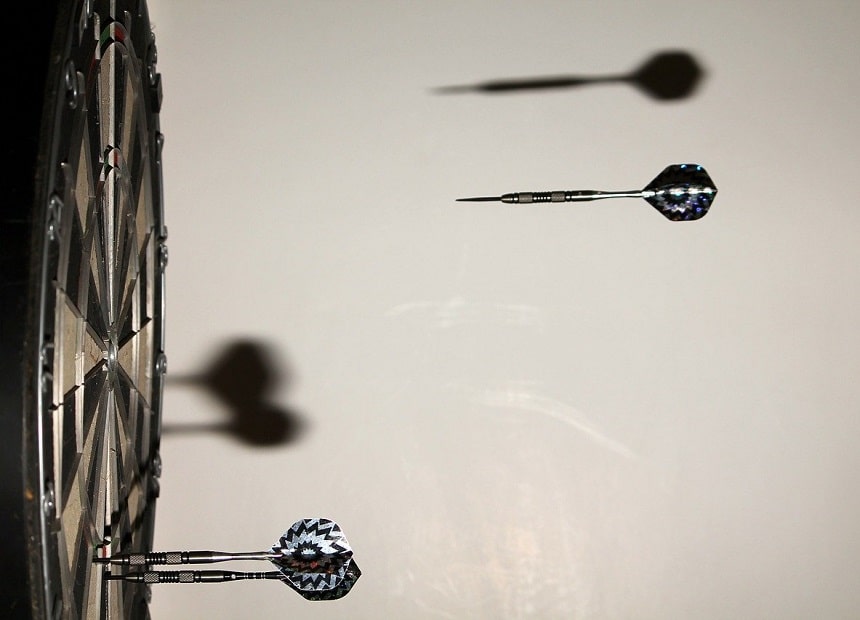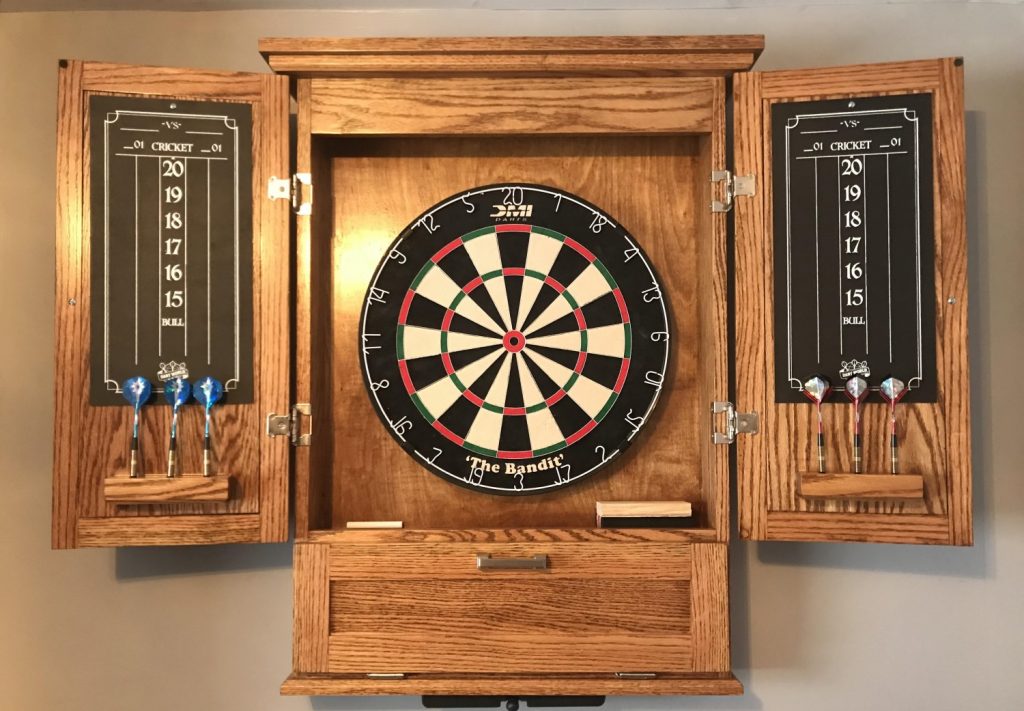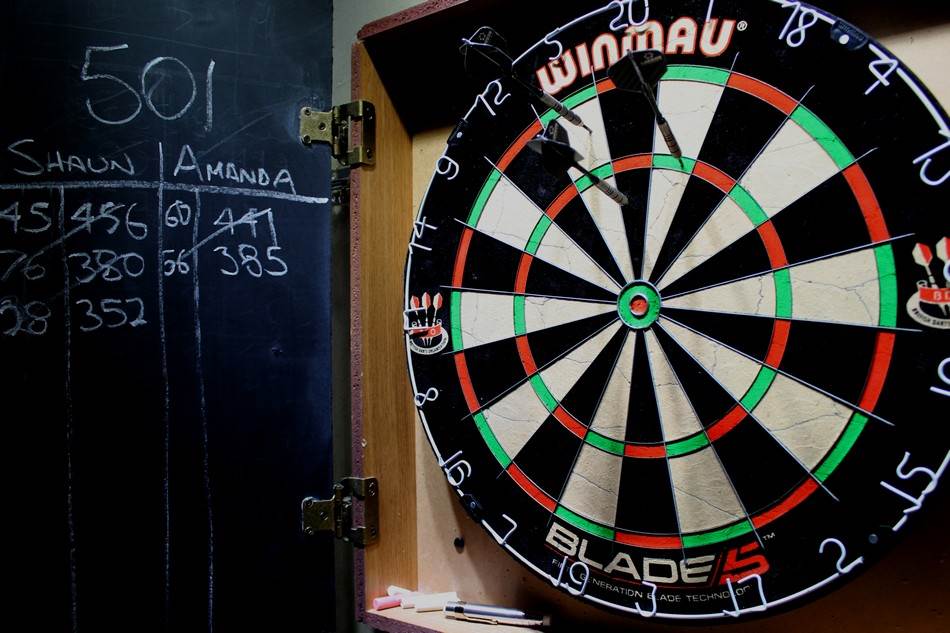If you have ever sat to watch a game of darts, whether in person or from a screen, it can be awe-inspiring to see how the professionals manage to hit the target using such small objects and from a considerable distance. You might wonder aloud “how do they do it?” Well, in this post, we will discuss how to throw a dart accurately. And by reading this post, you will also learn how to take your dart throwing skills up a notch. Read on to find out more!
What do you need to throw darts accurately?
Unless you are a gifted savant or a prodigy, you must know the basics about darts and the techniques behind throwing them. You will have to know important things like:
- Stance
- Grip
- Distance
- Position
- Rules
In this post, we will consider all of these factors in more detail. When you know these, you will find yourself getting better at throwing darts.
Rules of darts
Before we talk about all the important techniques that you have to master, it is vital that you know the rules of the game. Else, you’ll be wasting your time learning the techniques. If you do not understand the game that you are playing, then learning the techniques will be fruitless. With that in mind, let us see the history of the game and the rules that guide anyone that wants to play.
Dart playing has been a feature in several cultures; after all, it is like shooting arrows, but this time with the fingers. Before 1925, there weren’t any rules that guided how to play the game.
However, in 1925, the NDA published the standard rules of the game. Therefore, from major events to pub matches, players all around the world now had a way of standardizing the game. Before the rules were published, many people had their set of rules, which as you can expect, was no little cause of confusion and conflict in pubs around the country.
A traditional darts game is known as a 301 or 501 match or game.
The standard game involves throwing a specified round of three darts towards a designated target on the dartboard. Each game has a throwline, from behind which the player throws the darts.
So, what is the aim? Well, the aim of the 501 game is to reach the zero mark in the fewest number of rounds possible. Since the dartboard has different zones, these zones help to calculate the scores. Therefore, your score is determined by the zone the darts thrown land in.
Even as a novice, it is clear that the bullseye is the best position and is what players aim for. The closer the player is to the bullseye, the bigger the score.
Although the bullseye is very attractive to aim for during a game of darts, many experience players would rather aim for treble 20. With that, they will get a 60 score, which is higher than the 50 they’d get from hitting the bullseye.
A dartboard comes with an outer and inner ring. When you hit the outer ring, your score is multiplied by two, while hitting the inner ring will triple your score.
The aim of every game is to be the first to reach the 0 score. If a player goes below that, then the other player wins.
Now that you know the basic rules of the game, let’s now teach you how to throw correctly.
How to throw correctly
Before we have an in-depth review of the crucial things that will help you to throw better, it is important to know that different players have the techniques that work for them. As you play darts, you will find techniques that work for you and others that do not. Therefore, we recommend that you choose styles that are the most comfortable for you, and that will help you to play much better. As a darts player, know that there is always room for improvement.
One of the very first things to find out is which of your feet is the front foot. To do this, have a friend push you forward. The foot that you put forward to balance yourself is likely your front foot.
This isn’t set in stone, though, so you should find out other means of knowing your front foot.
With that in mind, let’s see one important factor that will determine how well you throw darts – the stance.
Stance
You might hear players telling others to adjust their stance. Well, what is the stance? This is simply put, the position of your feet as you throw. Why is it important? Well, although you throw darts with your fingers, the way you stand will affect your stability. Therefore, your stance must improve your stability. There are different types of stances used by players, so let us consider each of them.
- Front-facing stance
As the name implies, this stance is when your feet face the dartboard. Your toes are directly facing the dartboard. In this stance, all the toes lie parallel to the throw line, with the tips just behind the throw line.
The front-facing stance is the easiest stance, which is why many beginners prefer it to other types of stances. It is comfortable and natural.
While it is a good stance for those just starting to play darts, it is jettisoned by most professional players. Why so? Well, this stance doesn’t allow you to lean in towards the dartboard as much as you’d like.
- Best foot forward
The next stance focuses on how you place your front foot. This is why you have to know your front foot. The front foot will be in front with the other foot just behind it.
When using this stance, the front foot and throwing arm should align on the throwline. This stance is wider than the front-facing stance; therefore, you can lean forward more as you throw. This will improve your accuracy.
- Angled stance
This stance is very similar to the first stance that we discussed. Like the front-facing stance, this stance has your feet almost parallel to the throwline. However, this is where the similarities end. In this stance, the feet do not point at the dartboard. There is no stipulation on the angle of the stance.
It is similar to the best foot forward stance because you can also lean in well as you throw the darts.
- Side-on stance
If you are a beginner, this is one of the hardest stances to master. However, it is the most effective and is preferred by most expert players. In this stance, your front foot lies parallel to the throwline, while the other foot is in line with the throw line and front foot.
It is very effective, but the unnatural angle might make it hard to master.
Regardless of the type of stance that you choose to use, ensure that it is comfortable for you. And you can master the easier stances before you move on to more difficult stances. Once you get the right stance, you can rest assured that you’ll feel more confident with your throws.
Grip
After the stance, perhaps the most important factor that will help you to throw darts correctly is the grip.
Holding a dart is easy; however, if you do not hold it in the proper way, you will hardly hit the target you are aiming at. There are some things to remember when it comes to grip, and in this section, we will consider some of these tips.
Let’s see how to hold a dart.
How to hold darts
There are different ways to hold a dart. So, let’s discuss them.
Three fingers and a free finger
When watching pros play, you’ll notice that most of them use this grip. It is a highly recommended grip that gives you plenty of control over the dart while making it easy to release the dart.
One tip that you should have at the back of your mind is that the more fingers that you have on the dart; the more difficult it would be to release it. Why? Well, this is because all your fingers have to be released at the same time when you throw the dart. If the fingers are not released at the same time, it can affect the trajectory of the dart.
The ‘free finger’ refers to the fingers that are not in contact with the dart. When using this method, it is essential that you keep these fingers away from the dart. You might not realize it, but the slightest touch of your finger can affect the flight of the dart. Even the most perfectly lined shot can be ruined by contact with a free finger.
So, how many fingers should you use to hold a dart? Well, there isn’t a stipulated number. In this regard, players should choose what they feel works best for them. Some of the best players use just one finger and thumb to throw while others add another finger.
Tips on grip
There is no hard and fast rule on how to hold the dart. We recommend that when throwing; relax yourself and the arm as much as you can.
The best grip is neither too firm nor too lax, instead, it is firm and secure.
Unless you are ambidextrous, you will get the best throwing result when you use your dominant hand. It will feel natural and give you the right amount of weight behind it.
If you use your non-dominant hand, the grip can be too lax or too firm.
Another tip that we will give is to become the dart
Now that might sound corny and something out of a ninja movie, but it is the truth.
To that end, it is vital that you are completely familiar with your darts. When you know the darts well, you will understand how the weight and length will affect the trajectory of the darts.
When you understand the weight and length, you will be able to determine the amount of force required to throw the dart.
You should also consider the center of gravity of the dart. The more familiar you are with the darts, the better your muscle memory and throwing accuracy.
Consistent aim
To achieve a consistent aim, it is important to gauge the distance and target using your strongest eye.
The eye is very important to achieving a consistent aim. Therefore, use the eye that you feel very comfortable with. If you are a left-handed person, you will likely use your left eye and vice-versa.
How to release the dart
- Wrist snap
The release is majorly dependent on the flick of your wrist. Although the stance is important, never lose sight of the fact that the dart is thrown by the hand and wrist. Therefore, you should aim for the correct flick of the wrist.
Many beginners make the error of lunging forward when throwing darts. While some leaning is great, overdoing it can throw off your accuracy. As much as you can, remain in one position as you throw the darts.
- Pull-back action
As you throw, you want to avoid pulling back your arm immediately you release the dart.
Instead of pulling the arm, it is better to pull the hand slightly. This will give the dart more acceleration and will improve your accuracy.
Tips on getting better
As with almost everything in life, repetition is very important. So, to master throwing darts, you have to throw consistently. Therefore, seek out avenues to play frequently.
You should also seek out other players. When you play with others, you will see different types of techniques, some of which are great to imitate and others to be spurned. The more you play with others, the more you’ll push yourself to be better.
Conclusion
The key to learning to throw darts well is practice. Therefore, practice as much as you can. We hope that the information we have provided in this post will help you to take your dart throwing up a notch.

















